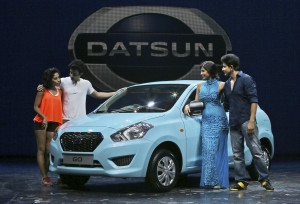
Indian artists pose with the newly launched Datsun Go car after their performance in New Delhi, India, Monday, July 15, 2013. Nissan has introduced the first new Datsun model in more than three decades in the Indian capital. The company hopes bringing back the brand that built its US business will fuel growth in emerging markets with a new generation of car buyers. The reimagined Datsun—a five-seat hatchback—will go on sale in India next year for under 400,000 rupees (about $6,670). AP PHOTO/MANISH SWARUP
NEW DELHI—Japanese carmaker Nissan resurrected its iconic budget Datsun marque on Monday to woo a new generation of cost-conscious buyers in emerging markets.
Nissan, which in 1981 killed off the Datsun badge that was a favorite of legions of Western drivers, has launched a “next-generation” of the car to penetrate high-growth developing economies.
Nissan Motor Co chief executive Carlos Ghosn unveiled the first new Datsun model in the New Delhi satellite city of Gurgaon.
The car is set to go on sale early next year in India, the world’s biggest small car market by volume.
“The Datsun is back!” Ghosn declared at the car’s world premiere as he showed off the five-door hatchback which features a front-wheel drive, swept-back headlights and a sporty grill.
The 1.2-litre engine car will also be rolled out in Russia, South Africa and Indonesia in the next couple of years.
There are no immediate plans to sell it in the United States or Europe.
Ghosn, who also heads French carmaker Renault as part of a partnership, said Nissan has retained the Datsun brand concept of “reliability and fuel-efficiency” but “completely updated the product.”
He gave no sticker price for the car, to be known as the Datsun GO, but said it would be less than 400,000 rupees ($6,678).
With the relaunched Datsun, which will be locally assembled, Nissan aims to fill a low-cost niche from which it has been absent, while keeping its main Nissan brand upmarket.
The Datsun, which first went on sale in 1931 and was known as one of the auto industry’s iconic brands, was sold in 190 countries.
But Nissan scrapped the well-known name almost three decades ago, opting to use its own badge for the cars in what was a shock brand change for many loyal owners.
Ghosn said the new Datsun would give Nissan a “meaningful presence in high-growth markets.”
Nissan aims to have a 10 percent market share in India by 2016, up from less than two percent last year.
In a couple of years, Nissan expects 60 percent of all auto sales globally to take place in high-growth markets such as India, Indonesia and Russia, Ghosn said.
In the United States, 500 out of every 1,000 people have cars, while in Russia the figure drops to 280. In South Africa, the number falls to 160 and it is 70 in Indonesia, he noted.
In India, which has a population of 1.2 billion and where global automakers see the greatest ultimate potential, car owners represent just 15 out of 1,000 people.
“There is a signficant transition (in buying patterns) in global markets,” Ghosn said.
But Datsun will not face an easy ride in India’s fiercely competitive auto segment, where market leader Maruti Suzuki, controlled by Japan’s Suzuki Motor, sells its low-cost Alto hatchback for less than $5,000.
India’s no-frills cheapest car, the Tata Nano, sells for a minimum 150,000 rupees or just under $3,000 but has not fared well amid product image problems.
The Datsun rebirth also comes as the Indian market is going through a tough period, with sales shrinking last year for the first time in a decade against the backdrop of a sharply slowing economy.
“It looks like a good product but it will be tough going—they’re starting essentially from zero in this segment,” auto analyst Deepesh Rathore told AFP.
Datsun’s revival follow Ghosn’s success in pushing Renault’s low-cost Dacia marque which has been overtaking rivals in Europe’s contracting car market.—Penelope Macrae